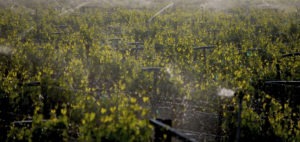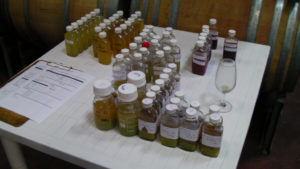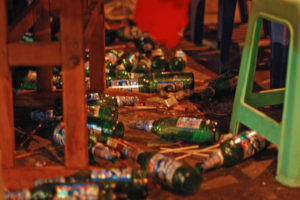It’s very difficult, if not impossible, for one single person to thoroughly review every single piece of peer reviewed literature related to wine that is published every day. This Wine Literature Review Lightning Round series presents three new papers (within the past year or two) in one post by briefly summarizing the research and linking to the abstract in order for you to pursue further if you’re interested.
DROUGHT MITIGATION/VITICULTURE
With drought in parts of the world an increasing threat, many communities are looking into the use of recycled wastewater for irrigation of crops, and in some cases, for personal consumption. There are many sources for wastewater, with one of them being from the winery itself. According to a 2009 study, for every 1 gallon of wine produced, there is 7 gallons of wastewater generated. With 806 million gallons of wine produced in the US in 2016 (Wine Institute), 680 million gallons of that coming from California, that is 5.6 billion gallons (4.8 billion in CA) of water that would potentially go to waste.
A 2017 study, published in the journal Agricultural Water Management, aimed to determine

Photo by Flickr user Craig Camp
how using winery wastewater to irrigate vines in Napa and Sonoma counties could affect chemical and sensory characteristics of wine produced from grapes grown on those vines.
Brief Methods
The two vineyard sites were located in the Napa Valley AVA and Alexander Valley AVA. The treatment vines in the Napa Valley site had been irrigated with winery wastewater for 3 years prior to this study, while the treatment vines in the Alexander Valley site had been irrigated with winery wastewater for 21 years prior. Control vines (not exposed to/treated with winery wastewater at both sites were used for comparison.
Irrigation and wastewater samples were collected at harvest from both control and wastewater irrigation treatment sites and tested for: pH, electrical conductivity, ammonia, and nitrates.
Soil samples were collected at varying depths and tested for: pH, soil electrical conductivity, total carbon, and total nitrogen.
Leaves were collected at mid-veraison and harvest and were weight and processed to test for various cations.
Grapes were collected at veraison and harvest and tested for: pH, TA, total soluble solids, ammonia, malate, yeast-available nitrogen, residual sugars, as well as various cation and phenolic compounds.
The Napa Valley site grew Sauvignon Blanc grapes, while the Alexander Valley site grew Cabernet Sauvignon grapes.
Wines made from control and winery wastewater irrigated treatment grapes were bottled, stored for 3 months, then tested for sensory and chemical characteristics at UC Davis.
Brief Results/Conclusions
Water: Sodium and potassium levels were higher in winery wastewater than the control water.
Soil: Sodium and potassium levels were higher (more accumulated) in soil from the winery wastewater irrigation treatment compared with the control.
Leaves: Leaves from vines grown in the winery wastewater treatment had higher levels of sodium and magnesium, and lower levels of potassium and calcium, compared with the control. The researchers noted that the levels present were not high enough to limit growth.
Grapes: There were no clear trends noted in the grapes between treatments, and no linear relationships with the cations in the leaves of the vines from which they came.
Wine: There were some differences in phenolics between the wines made from winery wastewater irrigated grapes and the control, however, sensory analysis showed no difference between the two (and thus any phenolic differences were considered minor).
Overall, the results of this study seemed to indicate that using winery wastewater as an irrigation treatment might be a viable alternative to traditional irrigation, and one that would help reduce waste within the winery and improve overall sustainability of the winery. While there was some cation accumulation in the soil and leaves, the levels were low enough to not be problematic in terms of growth at least in the short term. More long term studies should be done to see if there are any problems further down the road.
Of course, the composition of the winery wastewater at the start must be taken into consideration, with the literature recommending that it is safe to use when nitrogen levels in the water are less than 50mg/L and is not saline. Finally, the results could also be dependent on the variety of grape and the soils in which the vines grow, so extending this study to other varieties and other soil types would provide even more useful information for those interested in using winery wastewater as the source for irrigation.
Source:
WINEMAKING
Winemakers often put their wines through the process of fining for a variety of reasons: to remove unwanted particles, to aid in wine clarity, to reduce bitterness and astringency, just to name a few. There are several types of fining agents on the market, with animal protein-based agents being a common choice (egg albumin, casein/milk protein, etc). However, with the allergenic potential of some of these animal-based fining agents, many have sought out alternatives that are derived from plants (like pea and potato protein, for example).
A 2017 study, published in the Australian Journal of Grape and Wine Research, aimed to examine the potential for grape seed extract to be used as an alternative fining agent, as extracts from grape seeds have been shown to reduce astringency in red wines in other studies.
Brief Methods
The grape seed extract used in this study was created by using grape seed flour as the base, which is a by-product of the grape seed oil industry.
Red, white, and rosé wines were vinted using a variety of different fining agents: ovalbumin and gelatin for red wines, and patatin, pea proteins, polyvinyl-polypyrrolidone and potassium

Fining trials (plus some other tests). Photo courtesy Flickr user Robert Pitkin
caseinate for white and rosé wines. All three wine styles were also made using grape seed extract as the fining agent for comparison.
Chemical and sensory analyses were performed on all wines.
Brief Results/Conclusions
For white wines, grape seed extract was shown to be effective in reducing turbidity (compared with the potassium caseinate fining agent).
For rosé wines, grape seed extract improved the sensory characteristics by reducing vegetal characteristics in the finished wine.
For red wines, grape seed extra reduced some anthocyanins and proanthocyanins, and affected color only marginally. Wine mouthfeel was improved with grape seed extract, with the reduction of acidity and astringency after fining.
Overall, grape seed extract appeared to improve a variety of characteristics, including turbidity, color, oxidative stability, and sensory characteristics.
According to the researchers, the results indicate that grape seed extract could be a viable alternative to other fining agents for winemaking, and since the product itself is derived from grapes, it might not fall under the same legal restrictions as other types of agents in different parts of the world.
Source:
HEALTH
Binge drinking is fairly common among young adults, with a 2013 estimate pointing at 30.5% of 18-20-year olds in the US having five or more drinks on at least one occasion in the past month. While we know that this age group DOES binge drink, it hasn’t (until now) been documented exactly WHAT they are binge drinking.
A 2017 study in the journal Addictive Behaviors, hoped to fill this void of information by aiming to evaluate the binge drinking habits of young adults aged 18-20 years, and to determine beverage-specific binge drinking patterns for beer, liquor, wine, and wine coolers.
Brief Methods
Data obtained from the Monitoring the Future study cohort was utilized for this study. After excluding participants due to a variety of factors (age, questionnaire and follow-up completion, etc), a total of 2,004 young adults were included in the analysis. Final sample demographic breakdown was: 56.3% female, 43.7% male, 71.2% White, 8.1% Black, 10.5% Hispanic, 10.1% Asian/other/missing race data.
5 alcohol use questions were asked using this basic question: “Think back over the last two weeks. How many times have you had 5 or more [insert beverage type here] in a row?”. This question was repeated 5 times for 1) overall alcohol, 2) beer, 3) liquor, 4) wine, and 5) wine coolers. Various demographic and socioeconomic characteristics were determined for each

Photo courtesy Flickr user timquijano
participant and analyzed.
Brief Results/Conclusions
Overall consumption of 5 or more alcoholic drinks in a row was reported by 31.4% of young adult participants.
Liquor consumption of 5 or more drinks in a row was reported by 22.6% of young adult participants.
Beer consumption of 5 or more drinks in a row was reported by 22.4% of young adult participants.
Wine consumption of 5 or more drinks in a row was reported by 4.5% of young adult participants.
Wine cooler consumption of 5 or more drinks in a row was reported by 3.0% of young adult participants.
Men were more likely to binge drink with liquor and beer, while women were more likely to binge drink with wine and wine coolers.
Two-year and vocational/tech college students were less likely to binge drink on liquor and wine and more likely to binge drink on wine coolers than four-year college students.
Young adults not in college were less likely to binge drink on liquor and more likely to binge drink on wine coolers and four-year college students.
Overall, this study provides information for the young adult (18-20-year-old) demographic in regard to their beverage-specific binge drinking habits. It appears young adults mostly binge drink with liquor and beer, and rarely do so with wine or wine coolers. As a former college student, all I have to say is “yep, sounds about right”.
*It should be noted this study was partially funded by the National Institute on Alcohol Abuse and Alcoholism.
Source:

1 comment for “Wine Literature Review Lightning Round: 16th Edition”